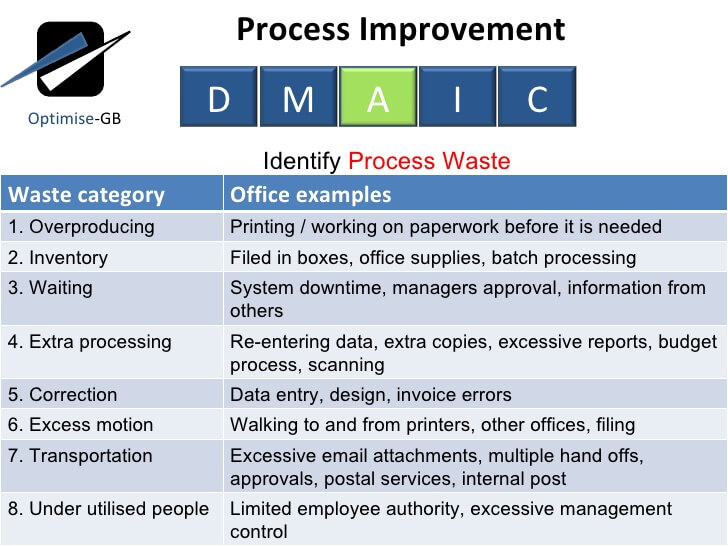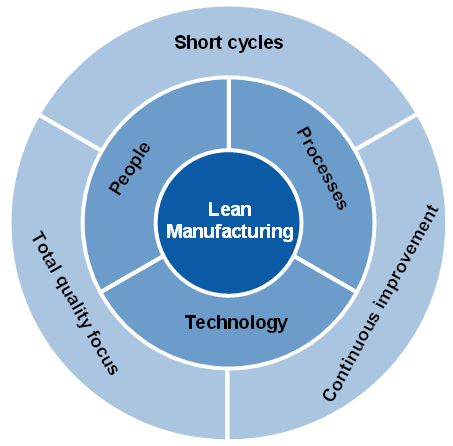A business process is directly defined as a string of activities within your organization typically performed by a group of people (though sometimes only one employee) with the aim of achieving specific goals or milestones.
Businesses often focus on trying to make these processes more efficient in order to save time and money, but it’s not efficiency that should be the primary focus. For any company to see positive growth and profit, the business processes it has in place needs to be effective.
I think we have to notice that the business processes we use right now for thinking and planning and budgeting and strategy are all delivered on very tight agendas.Margaret J. Wheatley
Source
Any time processes are improved, they should be done so for the purpose of making them more effective. Because even highly efficient processes may not be effective.
Process Improvement Examples

There are a number of process improvement examples that show how steps could be taken in a business to make things more effective as well as efficient.
Cost Cutting – One process improvement example is in cutting costs. Through restructuring processes, organization, and visualization it’s easy to spot redundancies and other items that wind up increasing overhead costs. From there, unnecessary tasks are dropped. That restructure allows for resources to be reallocated so you spend less while your processes flow better.
Reducing Communication Issues – Another business process improvement example is the improvement of communication. Process improvement is intended to improve functionality by streamlining communication, such as decreasing the number of emails and contact touch points between departments and employees. This is often achieved using software that allows employees and departments to see and share information – rather than chasing email threads through an inbox.
Process Visualization – With process modeling, it becomes far easier to audit and continually make improvements. Visualization allows you to follow the process and locate bottlenecks as they arise, or opportunities to make that process more efficient.
That auditing is one of the most critical parts of process improvement because every process you create needs to be monitored regularly. Without proper monitoring, you’re not really in control.
Process Improvement Examples – Types of Process Improvement
As businesses try to accelerate growth while running lean, there’s always a desire to reduce costs through process improvement. Like the examples above, this could include:
- Improving product quality
- Upgrade service quality
- Improve delivery times
- Reduce billing cycles
- Make production more efficient
There are three terrific process improvement examples seen in larger organizations, even down into SMBs.
LEAN Technology

LEAN Tech, also known as LEAN manufacturing, was a process that originated with Toyota. It was implemented to streamline the company’s production chain and dramatically reduce operating and overhead costs.
The key idea is to base process improvement on the customer perspective; taking the time to understand what they value from the product and then using LEAN process improvement to eliminate unnecessary waste, errors and other things that drive up costs. By focusing on value, the entire process is organized to drive more of what the customer is willing to pay for.
Six Sigma
Six Sigma is a process improvement example that focuses on achieving the maximum level of obtainable quality within an organization. At the Six Sigma level, that is a rating of near 100% perfection (or 99.9966%).
The Six Sigma approach looks closely at the root cause of problems, defects, and variations that reduce the effectiveness of processes. At its heart, there’s a philosophy of constant improvement that is in place to consistently and progressively improve results until that max level of perfection is achieved.
Top Quality Management
Six Sigma is a new process improvement example. The older approach, Total Quality Management, was crafted by W. Edwards Deming who was best known for the process improvements he brought to automotive manufacturing – particularly in Japan. Like Sig Sigma, Total Quality Management focuses on the elimination of errors.
Focusing on Continuous Process Improvement
Process improvement isn’t a one-and-done affair. Well-run businesses focused on growth needs to maintain continuous improvement. As those process improvements positively impact the bottom line, further investments in making operations more effective can be made.
Some continuous process improvement examples include:
Ideation and Think Tank Sessions
Companies should consider hosting regular ideation sessions, either open to all employees or strategically held to bring in key team members from each team or department. These sessions should also include key members of leadership. This way all ideas and perspectives are considered when generating new ideas for workplace improvements.
Rather than have a free for all of the ideas, you might want to have an agenda or list of topics to discuss. Then each individual or team is given the opportunity to present possible solutions.
Time Audits
One key approach to continuous improvement comes in auditing time. Set measurable benchmarks so you can track the time it takes to complete any specific job or task. This isn’t done at the employee or even leadership level. Instead, a professional researcher observes the work that is performed and makes a record of the time needed to complete the task.
Once this data is recorded, a study can be run to examine the data and establish the standards by which that process or task should be completed in the future. While the primary focus should always be on the effectiveness of process improvements, you should still target task efficiency to better control the costs involved in the production.
Monthly Training and Cross Training
Ongoing training is a smart choice for inclusion in ongoing process improvement. When you cross-train employees to work in multiple positions, you’re protecting your processes from bottlenecks that occur as a natural result of people-centric processes. Anything from a sick day to a vacation can have a negative impact on production.
Having trained staff that can rotate and fill a position helps to avoid any slowdown in production. For this reason, schedule monthly training programs that continually educate your staff.
Poll Everyone
The people who work directly within your processes have the best insight into the root cause of errors, and where things could potentially be improved. The savviest and watchful employees could likely give you a list, right now, of improvements that could be made.
Introduce surveys that go out to your vendors as well as your employees and customers, each with unique questions, to help you understand the impact of your process improvement efforts. The surveys can also provide a great deal of insight into things you didn’t even realize were a problem – or potential issue. There are some key questions your surveys should include:
- What are you doing that they believe to be satisfactory – how do you delight them?
- What could be done to improve the quality of products and services?
- What changes would they like to see in the future (let them prioritize what is most important to them.)
Take the data from those surveys, done at regular intervals, to score how your company operates, and how previous changes have (or have not) improved your processes.
Related Questions
What is considered a process improvement?
It has been suggested that process improvement is akin to “your work methods getting a makeover”. It’s a matter of figuring out smarter, faster, cheaper ways of doing things. Picture you’re assembling deli sandwiches. If you rearrange your ingredients so that they are more accessible, or find a shortcut for spreading butter, that’s process improvement. It is all about adjusting the way we work in tiny ways to make life easier, save time or enhance quality. Often it’s a small change, such as incorporating a new tool, and other times it’s a seismic shift, like completely reimagining the way a team can work together.
What are the four areas of process improvement?
Consider process improvement as a four-part puzzle. There are efficiencies, for one — making or using things more quickly or with less waste. Second: quality — quality assurance that our work is of the highest quality and error-free. Third is customer satisfaction – keeping our users (yes, all of us) happy and coming back for more. Finally, of course, is a need to save money — to save without cutting corners. All four of these components work together in perfect harmony. We can, for instance, pay to become more efficient, and with more efficient systems often come higher quality, happier customers and reduced costs. You’re killing four birds with one stone!
What is an example of a process improvement goal?
Let’s say you own a pizza parlor. A good process improvement target could be: “Lower delivery time to 80% of prior time in 90 days without sacrificing any pizza.” This goal is specific (faster by 20%), measurable (we can time deliveries), achievable (it’s not asking the impossible), relevant (faster delivery makes customers happy), and time-bound (three months). How might you do that? By changing the layout of your kitchen, by teaching your staff faster ways to make pizza, by optimizing your delivery routes. And here is the beauty of this goal: It’s not just about going faster; it can also get you happier customers, lower costs and maybe even more orders. It’s as if you gave a turbo boost to your entire pizza operation!

